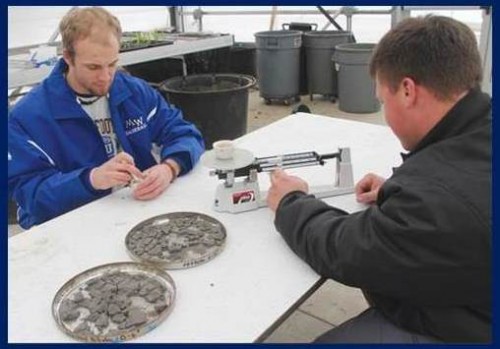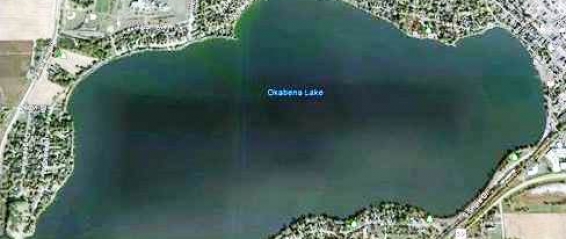Lake Savers Considered for Large Lake Project in Minnesota
Article Excerpt:
Michigan-based Lake Savers offers an aeration system they say will improve water quality and reduce the number and severity of algal blooms. The company has systems operating in several lakes in Minnesota.
“The way the aeration works is you reduce oxygen to the lake and introduce bacteria and enzymes,” explained OOWD Administrator Dan Livdahl. “That increases the rate of decay of the organic matter at the bottom. If you have a lot of organic matter, you would gain depth.”
Jay Milbrandt, a recent addition to the OOWD board, had learned of the Lake Savers products during his own research on water quality improvement for Lake Okabena.
Link to article: http://www.dglobe.com/event/article/id/63263/
Full Article:
Minnesota West students hope to help in improvement of lake quality
By: Julie Buntjer, Worthington Daily Globe
WORTHINGTON — Students in Jeff Rogers’ intro to soil science class at Minnesota West Community and Technical College’s Worthington campus are in the process of drying samples of sediment collected from Lake Okabena and Whiskey Ditch to determine how much organic matter is in the sediment found at the bottom of Worthington’s lake and inlet
WORTHINGTON — Students in Jeff Rogers’ intro to soil science class at Minnesota West Community and Technical College’s Worthington campus are in the process of drying samples of sediment collected from Lake Okabena and Whiskey Ditch to determine how much organic matter is in the sediment found at the bottom of Worthington’s lake and inlet.
The work is part of a process the Okabena-Ocheda Watershed District is pursuing in hopes of finding a way to improve water quality in Lake Okabena.
During its monthly meeting Tuesday, board discussion focused on aeration systems. This comes a month after board members decided to try some of the locally-manufactured Bioverse products in Whiskey Ditch and in a storm water treatment pond near the Glenwood Heights addition on Worthington’s west side.
Michigan-based Lake Savers offers an aeration system they say will improve water quality and reduce the number and severity of algal blooms. The company has systems operating in several lakes in Minnesota.
“The way the aeration works is you reduce oxygen to the lake and introduce bacteria and enzymes,” explained OOWD Administrator Dan Livdahl. “That increases the rate of decay of the organic matter at the bottom. If you have a lot of organic matter, you would gain depth.”
Jay Milbrandt, a recent addition to the OOWD board, had learned of the Lake Savers products during his own research on water quality improvement for Lake Okabena.
“We don’t know the science behind it and how well it will be effective here on Lake Okabena,” Milbrandt told the board. “The bioenzyme metabolizes some of the organic material and the muck at the bottom of the lake. (Lake Savers is) seeing a two- to three- feet increase in lake depth (with 30 percent organic matter in the sediment) and a 60- to 70-percent reduction in algae. There’s still a lot to be learned.”
Livdahl said he suspects the composition of the sediment at the bottom of Lake Okabena will have less organic matter and more mineral content, meaning that the results may not be as good here. The higher mineral content is anticipated because the water coming into the lake is surrounded by agricultural land, rather than the trees and grasses that would increase organic matter.
He collected sediment samples from Whiskey Ditch, as well as from Lake Okabena — the middle of the lake and approximately 1,000 feet south of the outlet from Whiskey Ditch — on Feb. 22. Rogers’ class has since oven-dried the samples at 200 degrees for 48 hours, and then placed them in a high-temperature furnace set at 1,000 degrees F. for two hours to burn off the organic matter. Students will reweigh the samples in class today and calculate the percentage of organic matter in the soil.
Once the level of organic matter in the sediment is known, Livdahl said it can determined how much more lake depth could be achieved.
Milbrandt said the product, if it could increase water depth in Lake Okabena by even a foot, would be cheaper than dredging the lake. The company has said its products could reduce algae by as much as 56 percent and increase lake depth by six inches in the first two years.
“This company provides a lease with guaranteed results, but we’d need to know more about the results,” Milbrandt said.
Beyond the “science” of the product Lake Savers offers, the board is also concerned about the cost — estimated at $600,000 to $800,000 — for approximately 37 miles of aeration piping that would be needed to crisscross the lake.
In other news, the board:
l Learned that an invasive species education meeting has been scheduled for 7 p.m., April 23 in the Farmers Room, located in the lower level of the Nobles County Government Center in Worthington. Ryan Doorenbos, fisheries manager with the Windom office of the Department of Natural Resources will talk about invasive carp, and there will also be discussion on zebra mussels. The game warden will also be present to talk about more stringent rules. The event is free and open to the public.
l Has requested funds from the E.O. Olson Trust to help fund Bioverse products at the two test sites this summer. The E.O. Olson Trust board will meet in April.
l Discussed the potential for carp removal from Lake Ocheda. OOWD Advisory Board member Dick Duba asked if the watershed can do anything to stop the carp from coming into Lake Ocheda from Lake Okabena. Attempts in the last two years to get the only licensed commercial fisherman for the southwest Minnesota district to seine the lake have been unsuccessful.
The hope now is there will be a significant fish kill on Lake Ocheda because of the reduced water levels going into this winter.
“If we get a fish kill, the DNR will come in with perch and hopefully lots of northern — predator fish that can eat the carp eggs,” Livdahl said. “The plan is to stock the lake heavily with good fish.”
Lake Ocheda, at nearly 1,700 acres in size, has been estimated to have 600 pounds of carp per acre — or more than 1 million pounds of carp in the entire three-basin lake and adjacent sloughs.
Tags: minnesota west, lake okabena, news, water, worthington
























